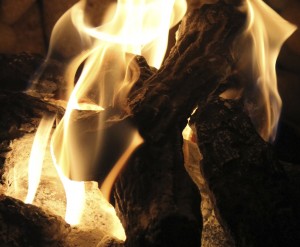
Fire Safety on the Farm, Reduce Your Risk
By: Barbara Sheridan/Equine Guelph
Barn fires are every horse owner’s worst nightmare, one that can bring significant emotional and economic loss. However, the sad fact is that many barn fires could have largely been prevented by applying a few basic principles. The most reliable approach to fire safety is to plan for the worst by having solid procedures in place for fire prevention and adhere to them daily.
Education, awareness, and planning are key to minimizing the risk of fire, says Victor MacPherson, District Chief of the Adjala-Tosorontio Fire Department. “Barn fires still continue to happen though we try our best, as we are lacking the education connection with the property owner,” he says. “The reasons we encounter barn fires result from years of improper setup, poor maintenance and poor house cleaning.”
Fire is caused when a “fuel” and “ignition” source meet. Hay, bedding, and wooden materials are common examples of fuel found on the farm, while improperly cured hay, electrical malfunctions, and carelessness with smoking are common sources of ignition. Practicing simple protection and prevention techniques will help keep these two elements from contact.
Data released in 2012 by the Office of the Fire Marshal and Emergency Management in Ontario indicated $57.6 million in losses in buildings classified under the National Farm Building Code in 2007, notes Ralph Snyder, Assistant District Chief of the Adjala-Tosorontio Fire Department. This represents a 67.4% increase over the previous year’s loss of $34.4 million due to fire. With the evolution toward large-scale farming and associated farm buildings increasing in value, the financial losses continue to climb.
“When these large structures catch fire, they are more difficult to control and extinguish, resulting in greater financial losses to both the structure and its contents,” he adds.
Electrical malfunctions are a primary ignition source for many fires including barns, advises Snyder. “Farm buildings can be at an increased risk because of the corrosive environment found in livestock barns,” he says. “This causes corrosion of exposed metal components [such as wires, connections, etc.], which creates increased resistance and heat at wiring connections. This can result in ignition of surrounding combustible materials. The Electrical Safety Authority has stringent requirements for installation of electrical equipment in animal confinement areas.”
In order to offset any potential fire hazards, Snyder recommends having an annual electrical inspection done by a qualified electrician to check for signs of deterioration or corrosion and repair any issues that are found.
In addition, all electrical wiring, switches, or plugs should be placed well out of a horse’s reach and covered in weather proof boxes or conduit. All light fixtures should be caged and approved for stable use. When not in use, electrical equipment should be unplugged and properly stored away. Special attention should be paid to water bucket heaters, as they continue to heat even when the water bucket is empty. This could result in the plastic melting and igniting stall bedding and hay.
“In our experience, we find that barn fires seem to be more prevalent in cold weather conditions,” states MacPherson. “For example, the heating/electrical system can be taxed pertaining to drinking water freezing and thawing, and allowing the watering buckets to run dry. This leaves the elements exposed causing bedding or other combustible material to ignite. We have also found that in the fall months, improper storage of fall crops contain too much moisture and spontaneous combustion occurs in the stored feed.”
Good Housekeeping Starts Now
MacPherson says the best way to combat stable fires is to identify all potential ignition sources and take the necessary steps to eliminate them. This starts with good housekeeping, which includes installing a fire detection system and keeping the system functional and operational by keeping the sensors clean and in good working order.
“Depending on the value associated with your stable, a dry sprinkler system with the connection outside the barn for fire department connection, or an independent pump system, would be a valuable tool to stop the spread of fire,” he says.
Other important housekeeping steps include keeping the stable clean and free of clutter such as cobwebs and dust, which are excellent fuel sources. Any loose hay or straw should be swept up and disposed of properly. The removal of potential combustible materials also includes the trimming of weeds, grasses and brush from around buildings and regular removal of rubbish. Equip all buildings with a minimum five pound ABC fire extinguisher at all exits and in any mechanical and feed rooms, and make sure employees know how to use one.
Another important tip is to regularly maintain farm equipment and have it stored in a separate building. It is also recommended that hay and bedding be stored in a building separate from where the horses are kept or that it be restricted to a separate section of the stable separated by a firewall. Enforce a “No Smoking” policy in and around the facility and post signs prohibiting this where they can be easily seen.
“We highly suggest that every stabled horse has a halter that fits hanging on their stall door with the lead rope attached,” he says. “Leather is preferable, as a nylon halter can melt in the heat. Consider marking each halter with glow-in-the-dark paint or attaching reflectors to assist during times of poor visibility.”
MacPherson strongly recommends that farm owners prepare a site-specific fire safety plan, known as a “pre-plan.” This would include mapping out the location of where all animals are being housed, as well as the location of all emergency utility shutoffs, and identifying all buildings on the property and sources of water available, should firefighters require access to it.
“Have a detailed fire plan, which includes listing the location of combustibles and where feed is stored, with a copy given to your local fire department for their pre-plans,” he says. This would greatly assist firefighters in familiarizing themselves with your property before a fire happens.
Stable owners can consult with their local fire department for advice on preparing a pre-plan and obtain information on fire prevention. Most fire departments will visit your farm if invited and point out ways to minimize potential fuel sources on their property. This would be especially beneficial before one begins to renovate their stable or build a new facility.
Keep the Plan Prominent
There is no such thing as a fireproof building, and no matter how well you prepare, accidents can happen. Develop a fire emergency plan ahead of time, keep it readily accessible and practice the plan prior to any emergency, as these steps will assist in keeping you and your horses safe. In case of fire, it’s important to remain calm, call 911, and proceed with the emergency plan. Once the fire crew arrives, step aside, wait for direction, and let the professionals do what they’re trained to do. For further information on preparing an emergency plan, please refer to When Disaster Strikes, Plan to be Prepared.
In case of an emergency, Snyder recommends that the stable’s physical address be posted in a prominent place, preferably by the phone should someone who is not familiar with the address be making the emergency 911 call. Also make sure that the address can be easily seen from both directions of the road in order to get the fastest response.
“Always keep an open roadway around the perimeter of buildings for access by heavy firefighting equipment, and then keep it well-maintained so that it is accessible year around,” he says.
Every stable user should have fire safety in mind. Plan ahead with fire prevention practices and have an up-to-date pre-plan on hand to help to reduce the risk of fire.
“Education of fire prevention awareness is fundamental to both the property owner and hired hands,” says MacPherson. “Internet information from reputable sources such as universities and colleges of agriculture offer valuable information, as well as discussing any concerns with your local fire department.”
Sign up for our free e-newsletter at EquineGuelph.ca which will deliver monthly welfare tips throughout 2014 and announce tools to aid all horse owners in carrying out their ‘Full-Circle-Responsibility’ to our beloved horses.
Visit Equine Guelph’s Welfare Education page for more information http://www.equineguelph.ca/education/welfare.php
In partnership with the Ontario Ministry of Agriculture and Food, Equine Guelph is developing a ‘Full-Circle-Responsibility’ equine welfare educational initiative which stands to benefit the welfare of horses in both the racing and non-racing sectors.
Want to learn more? Equine Guelph will be hosting an Emergency Preparedness Workshop for Horse Owners in Guelph on Sept 18, 2014 followed by a Technical Large Animal Emergency Rescue Awareness and Operations Level Course on Sept 19, 20, 21.
Recently Added
- The Equine Chronicle Office Will Be Closed from July 3rd through July 6th July 1, 2025
- Around the Rings – 2025 Southland Circuit & American Roan Horse World Show July 1, 2025
- Ashlyn Montague and An Original Best crowned World Champions at Inaugural Amateur Western Versatility July 1, 2025
- AQHA and Thoroughbred Hall of Famer D. Wayne Lukas Passes Away July 1, 2025
- Steven Rissman and Starring Mr Hoyt triumph at 2025 APHA World July 1, 2025
- On The Cover – Sloane Weakly And Hubbout A Dance July 1, 2025
- EC Photo of the Day – APHA World Show 2017 July 1, 2025
- More Around the Rings – 2025 Appaloosa National & Youth World Show June 30, 2025
- EC Photo of the Day – APHA World Show 2016 June 30, 2025
- The Year of the Comeback June 30, 2025
Sign In
Equine Chronicle ® All Rights Reserved. Copyright © 2025
4727 NW 80th Ave. • Ocala, FL 34482 • 352 369 1104 • FAX 352 369 1521
Privacy Policy | Questions, please contact The Equine Chronicle
-










